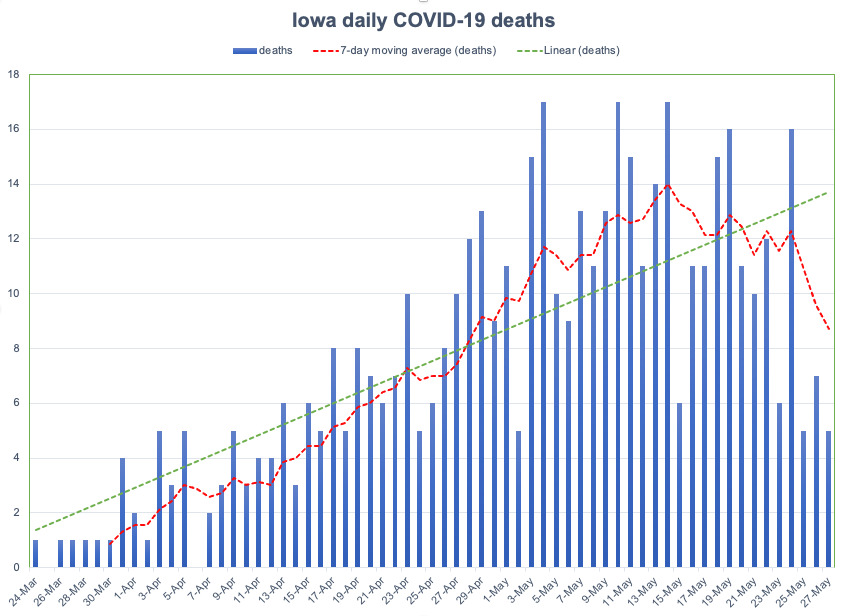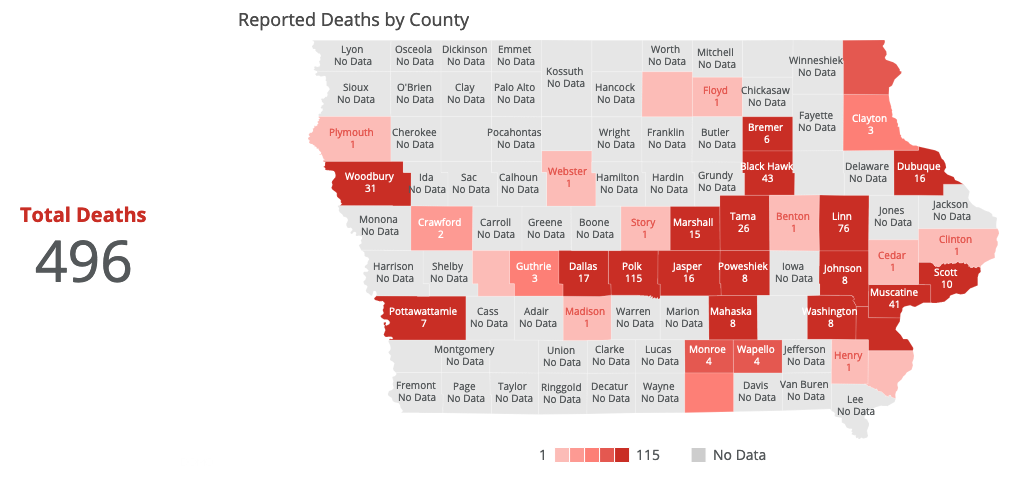A little more than two months after Iowa recorded its first death attributed to novel coronavirus, the number of reported COVID-19 deaths in the state has surpassed annual deaths by suicide in recent years.
Official figures show 479 Iowans took their own lives in 2017 and 477 did so in 2018, the last year for which full statistics are available. Suicide was the state’s ninth leading cause of death in both years. On the morning of May 27, the state’s COVID-19 website showed 485 Iowans had died in the pandemic. That figure rose to 496 by the end of the same day.
While explaining her recent decisions to reopen many kinds of businesses and venues, Governor Kim Reynolds has noted that certain COVID-19 mitigation policies could exacerbate mental health problems. During her May 20 news conference, she asserted that isolation and unemployment had contributed to an “uptick in suicides.” Communications staff for the Iowa Department of Public Health and the governor did not respond to Bleeding Heartland’s repeated inquiries seeking to confirm whether data exists pointing to more Iowans ending their lives since the pandemic began.
According to psychologist Jill Harkavy-Friedman, the vice president of research at the American Foundation for Suicide Prevention, “We’re two years away from having data” on whether COVID-19 increased the suicide rate.
Iowans experiencing suicidal thoughts can seek help and support by calling the state’s hotline at (855) 581-8111, texting (855) 895-8398, or using the online chat function here. Several nonprofit organizations offer support groups or other suicide prevention resources as well.
This graph shows Iowa’s recorded coronavirus deaths. The red dotted line represents the seven-day moving average, and the green dotted line represents the linear trend. In the past, I’ve charted deaths using the number the Department of Public Health had reported on each day. I have switched to the method now used on the state’s COVID-19 website, recording the date listed on the death certificate. Numbers for the last few days will likely increase as more fatalities are reported to the IDPH.
The state website includes this map showing COVID-19 deaths by county.
About 87 percent of the Iowans who have died of coronavirus were over the age of 60, official figures show. At least 228 who died had been residents of long-term care facilities. That does not include patients like Jay Daniels who were living in other senior communities, which the Iowa Department of Public Health does not define as long-term care.
An estimated 77 percent of Iowans who have died were white, and at least 81 percent were not Hispanic or Latino, official figures indicate. White people account for about 57 percent of confirmed COVID-19 cases at this writing. Although people of color make up a disproportionate share of Iowans who have contracted the virus, the disparity is less pronounced for deaths so far.
Given the rate of fatalities recorded this month, COVID-19 will likely surpass Iowa’s eighth leading cause of death sometime in June. Influenza or pneumonia killed an estimated 578 Iowans in 2017 and 672 people the following year. Those deaths occurred over the course of twelve months with no special mitigation efforts in place. COVID-19 has already killed nearly 500 Iowans despite social distancing policies including closing schools and many kinds of business in mid-March, along with restricting visits to residents of nursing homes.
Top image created by the Centers for Disease Control to illustrate “ultrastructural morphology exhibited by coronaviruses.”




1 Comment
By coincidence...
…the passage below appeared in a CEDAR RAPIDS GAZETTE piece today about a miraculously-recovered coronavirus patient. Good story by Michaela Ramm.
***
Hiles had gone to the hospital’s emergency room three times before he was finally admitted. He said he doesn’t remember much of that day because he was so sick, but said he knew Mercy Medical was following federal and state guidelines.
Those guidelines dictate patients needs to have a fever — a symptom Hiles did not have — before they would be tested for COVID-19.
Before making his third and final trip to Mercy Medical’s emergency department, he read online that he would be admitted to the hospital if he told emergency room physicians he was suicidal. So that’s what he said.
Hiles tested positive for the novel coronavirus and was intubated within 24 hours of his admittance to the hospital.
PrairieFan Thu 28 May 1:26 AM